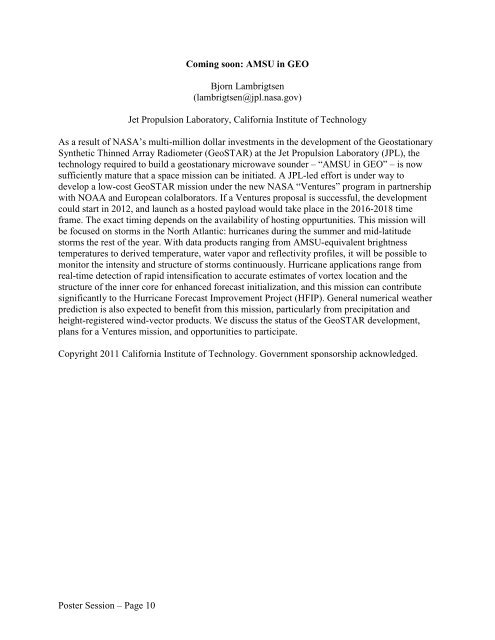65th IHC Booklet/Program (pdf - 4.9MB) - Office of the Federal ...
65th IHC Booklet/Program (pdf - 4.9MB) - Office of the Federal ...
65th IHC Booklet/Program (pdf - 4.9MB) - Office of the Federal ...
You also want an ePaper? Increase the reach of your titles
YUMPU automatically turns print PDFs into web optimized ePapers that Google loves.
Coming soon: AMSU in GEO<br />
Bjorn Lambrigtsen<br />
(lambrigtsen@jpl.nasa.gov)<br />
Jet Propulsion Laboratory, California Institute <strong>of</strong> Technology<br />
As a result <strong>of</strong> NASA’s multi-million dollar investments in <strong>the</strong> development <strong>of</strong> <strong>the</strong> Geostationary<br />
Syn<strong>the</strong>tic Thinned Array Radiometer (GeoSTAR) at <strong>the</strong> Jet Propulsion Laboratory (JPL), <strong>the</strong><br />
technology required to build a geostationary microwave sounder – “AMSU in GEO” – is now<br />
sufficiently mature that a space mission can be initiated. A JPL-led effort is under way to<br />
develop a low-cost GeoSTAR mission under <strong>the</strong> new NASA “Ventures” program in partnership<br />
with NOAA and European colalborators. If a Ventures proposal is successful, <strong>the</strong> development<br />
could start in 2012, and launch as a hosted payload would take place in <strong>the</strong> 2016-2018 time<br />
frame. The exact timing depends on <strong>the</strong> availability <strong>of</strong> hosting oppurtunities. This mission will<br />
be focused on storms in <strong>the</strong> North Atlantic: hurricanes during <strong>the</strong> summer and mid-latitude<br />
storms <strong>the</strong> rest <strong>of</strong> <strong>the</strong> year. With data products ranging from AMSU-equivalent brightness<br />
temperatures to derived temperature, water vapor and reflectivity pr<strong>of</strong>iles, it will be possible to<br />
monitor <strong>the</strong> intensity and structure <strong>of</strong> storms continuously. Hurricane applications range from<br />
real-time detection <strong>of</strong> rapid intensification to accurate estimates <strong>of</strong> vortex location and <strong>the</strong><br />
structure <strong>of</strong> <strong>the</strong> inner core for enhanced forecast initialization, and this mission can contribute<br />
significantly to <strong>the</strong> Hurricane Forecast Improvement Project (HFIP). General numerical wea<strong>the</strong>r<br />
prediction is also expected to benefit from this mission, particularly from precipitation and<br />
height-registered wind-vector products. We discuss <strong>the</strong> status <strong>of</strong> <strong>the</strong> GeoSTAR development,<br />
plans for a Ventures mission, and opportunities to participate.<br />
Copyright 2011 California Institute <strong>of</strong> Technology. Government sponsorship acknowledged.<br />
Poster Session – Page 10
















